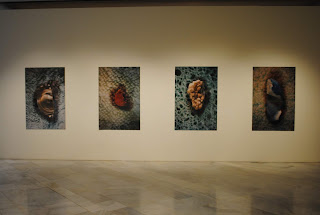It was my photographic intervention at the Carabanchel Penal Institution, December 1994, Madrid.
Only a few artists invited to create our work in a prison, it was about turning the jail into a forum for cutting edge art. Concha Jerez, Nacho Criado, Pepe Iges, Isidoro Valcarcel Medina, and other young artists, we came up with projects that could be developed in confinement circumstances with convicts who wanted to participate.
We proposed to reflection on the role of art in segregated and excluded territories It was about fostering a meeting, and a mutual surprise that of the artist who comes from outside, and that of the inmate who is invited to work.
Before our meeting, I asked myself a question: when I draw or photograph a face do I represent my face, without intending to, about the one I am trying to portray? This could be connected with the concept of empathy: the child responds to his mother's smile and imitating his gesture, he interprets the face of the closest person. For empathy when we make a portrait, we project our appearance on other faces.
A turning point in this project was in the first prison visit, I found unforeseen lighting circumstances, in a closed place, without natural light, we improvised a spotlight with the slide projector.
Presenting my work as a collaboration proposal, I asked the inmates for help and, I showed them images of me that provided information on the future results. Besides, I touched on some technical and personal aspects that could connect with their concerns as image-creating photographers inside the enclosure. I was interested in showing that it was possible to construct images in a small space and somewhat precarious circumstances to elaborate own language. They accepted my proposal.
Firstly I thought to include my hand in the image; but finally, I decided, during the development of the on-site work, their hand should appear, with an object that I carried, they chose. We would make a half portrait or a double portrait: my face and his hand. Their hands, and my face, all the same, but different, became a challenge for those who see the images. You can see many things on the hand: the footprints, the age, the future, the past too.
As you might know, I carefully wrote down who had taken each photograph, and whose hand it was. With this material, I continued working in the studio. I took nine photographs, one for each portrait taken in prison (nine were the participants: six prisoners and three educators) in the first phase, until obtaining satisfactory results.
I went back to jail and showed them the first evidence. I thought it is necessary to improve the quality of the results regarding sharpness and color and continued working in my studio. I took about 15 new pictures for each portrait. About 120 pictures. I made nine mural portraits of 100cm x 150cm, mounted, and screwed on methacrylate.
Although initially, the formal approaches were clear, the results obtained surprised me: my face was always smiling (in the photos, I had taken in my previous work, the appearance was serene, very calm).
However, this face in prison with a smile showed a complex emotional situation. The lighting was extremely dramatic; the shadow-light relationship turns the objects, face, and hand into appearances and contributes to giving a formal definition of the face and the different hand. Hands look like faces, faces look like hands. Is it the left or the right side? Is it a face or profile face?


















